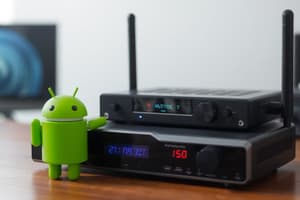Podcast
Questions and Answers
Fragments in Android are similar to Activities but larger in size.
Fragments in Android are similar to Activities but larger in size.
False (B)
Services in Android are responsible for drawing content on the screen.
Services in Android are responsible for drawing content on the screen.
False (B)
BroadcastReceivers in Android allow applications to only listen for messages from within the app itself.
BroadcastReceivers in Android allow applications to only listen for messages from within the app itself.
False (B)
Views in Android, such as buttons and textviews, are used to run background tasks.
Views in Android, such as buttons and textviews, are used to run background tasks.
Activities in Android can hold both Views and Fragments.
Activities in Android can hold both Views and Fragments.
BroadcastReceivers are mainly used to manage access to a central data repository in Android applications.
BroadcastReceivers are mainly used to manage access to a central data repository in Android applications.
ContentProviders always have their own user interface (UI) in Android applications.
ContentProviders always have their own user interface (UI) in Android applications.
The main purpose of using a ContentProvider in Android is to allow client applications access to data without the need for SQL operations.
The main purpose of using a ContentProvider in Android is to allow client applications access to data without the need for SQL operations.
The AndroidManifest file of an application lists the types of components present in the app, such as activities and services.
The AndroidManifest file of an application lists the types of components present in the app, such as activities and services.
A simple Android app displaying a screen to the user typically requires only two components.
A simple Android app displaying a screen to the user typically requires only two components.
Flashcards are hidden until you start studying




